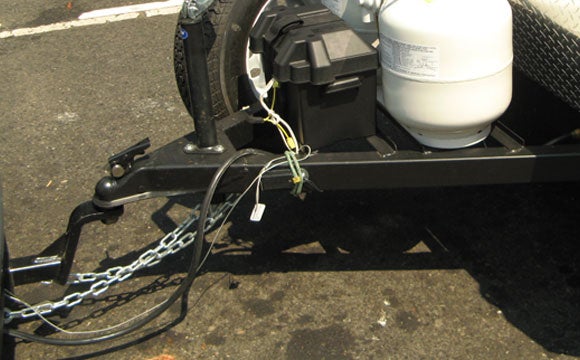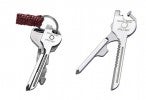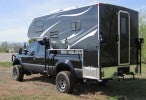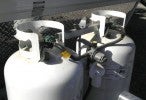Originally published by our sister site and magazine, PopUp Times.
By Bill Siuru
If your tow vehicle only has sufficient power to pull a trailer up a hill at a snail’s pace, it only inconveniences
you and maybe other drivers. However, if the brakes fail while descending a hill, it could be a disaster. Without brakes, the trailer will push against the tow vehicle, making stopping much more difficult. And if the trailer starts swaying, the trailer can jackknife because there is no way of controlling it.
Trailer brakes are not a nice option to have, they are a must on all but the lightest trailers. Two- wheel brakes — brakes on at least one axle — are required on trailers with Gross Vehicle Weights (GVW) of more than 3,000 pounds in 31 states, and 11 states require brakes on both axles of four-wheel trailers. States that do not require brakes have regulations that require the ability to stop a vehicle and trailer combination without sway from a specified speed within a specified distance. Usually, this translates to the need for trailer brakes. Check the regulations for your particular state. Besides increasing the chance of an accident, there are fines for driving with illegal equipment. And if you have an accident, you could be held responsible because you were operating a vehicle illegally.
There are two basic types of trailer brakes: electric and surge. Electric brakes are the most common. With electric brakes, stepping on the tow vehicle brake pedal activates the trailer brakes just slightly after the tow vehicle brakes are applied. A dashboard-mounted control box allows operation of the trailer brakes from the driver’s seat without stepping on the brake pedal in the tow vehicle. For instance, if the trailer starts to sway out of control, the trailer brakes can be worked by hand to regain control of the trailer without braking the tow vehicle.
The controls for electric brakes must be adjusted for optimum operation. Unlike vehicle brakes, which provide braking force that is proportional to the amount of pressure you apply to the pedal, the basic drag of electric brakes is set with the control unit. A pendulum-type control electronically adds additional braking action as you stop. However, if the controller is turned all the way up, the slightest pressure on the pedal could lock the trailer brakes. Learn how to adjust the controller properly from a trailer professional or a seasoned trailer “herder.”
Surge brakes are hydraulic brakes operated by a cylinder built into a tag-along type coupler that compresses as the tow vehicle slows. The more the tow vehicle brakes, the more the cylinder compresses to apply more trailer braking.
Both types of braking systems have advantages and disadvantages. Surge braking results in smoother braking than electric braking and require little skill to operate. Surge braking costs about $200-300 more per axle than electric braking. However, surge braking is a good choice if you plan to use more than one tow vehicle, since each vehicle requires its own controller at a cost of $150-$200 each. As with any electrical system, wiring problems and deterioration can be a headache with electric brakes. If you opt for surge braking, make sure it has a “free braking” feature that locks out the surge coupler so the brakes do not lock up when you try to back up. Also, check to make sure surge brakes are legal in your state. Some states require that trailer brakes be operable from the driver’s seat, which rules out surge brakes.
Don’t forget a breakaway brake and safety chains. Required by about a dozen-and-a-half states, a breakaway brake is an independent device that activates the electric trailer brakes if the trailer should separate from the tow vehicle. A removable pin on the unit’s battery box is attached to a cable, which is hooked onto the tow vehicle. If the trailer pulls free, the pin pulls out and the breakaway device activates the trailer brake. The cable should be attached to the frame of the vehicle or to the permanent part of the hitch, not to the ball or ball mount, as these parts may also pull free with the trailer. Even if breakaway brakes are not required in your state, it is a good idea to have your trailer equipped with one. Many new trailers come with a breakaway brake as standard equipment. Also, make sure the unit’s battery is always properly charged.
Trailers do come off, if they have not been properly attached or because of equipment failure. Therefore, 46 states require safety chains on tag-along trailers and 29 require them on fifth-wheel trailers. Even if not required, they are highly recommended. The safety chains should be attached to the frame of the vehicle or to the portion of the hitch mounted on the vehicle. Chains should be crossed underneath to catch the coupler in a sort of a cradle in case it comes off the ball. They should not touch the ground, but be long enough to let the trailer turn corners properly.
How the typical surge brake works.
Proper installation of safety chain –note the chains are crossed to cradle the coupler should it separate from the ball.
William D. Siuru, Jr., PhD, PE Automotive Journalist. 10694 Glendover Lane, San Diego, CA 92126 (858) 693-1487 siuru@mindspring.com


















 Your Privacy Choices
Your Privacy Choices